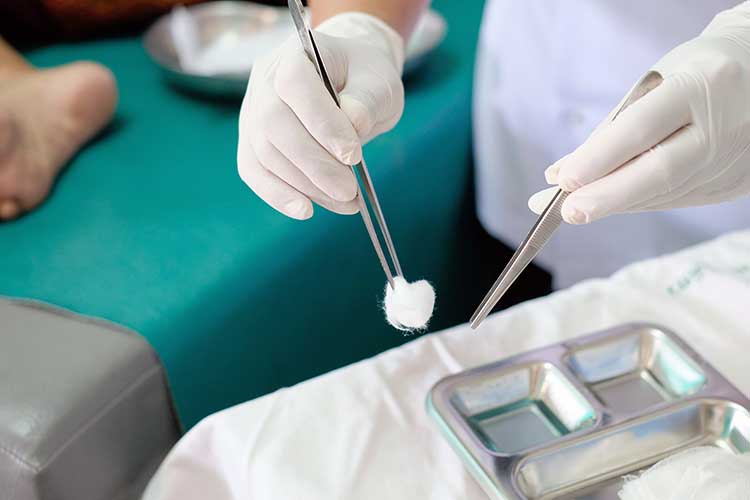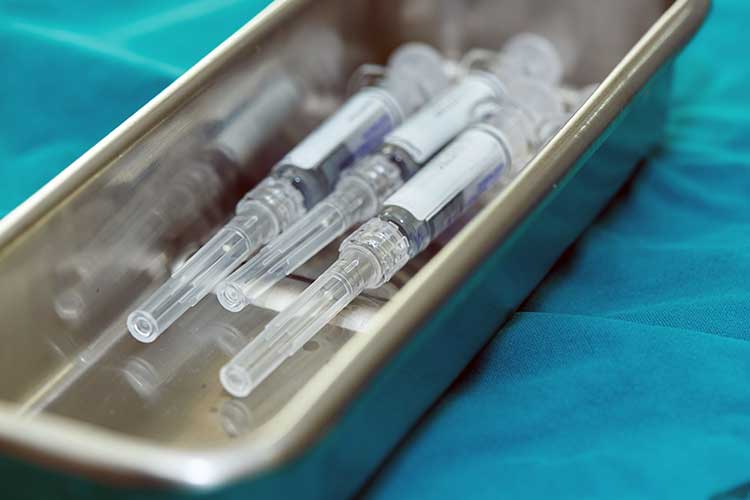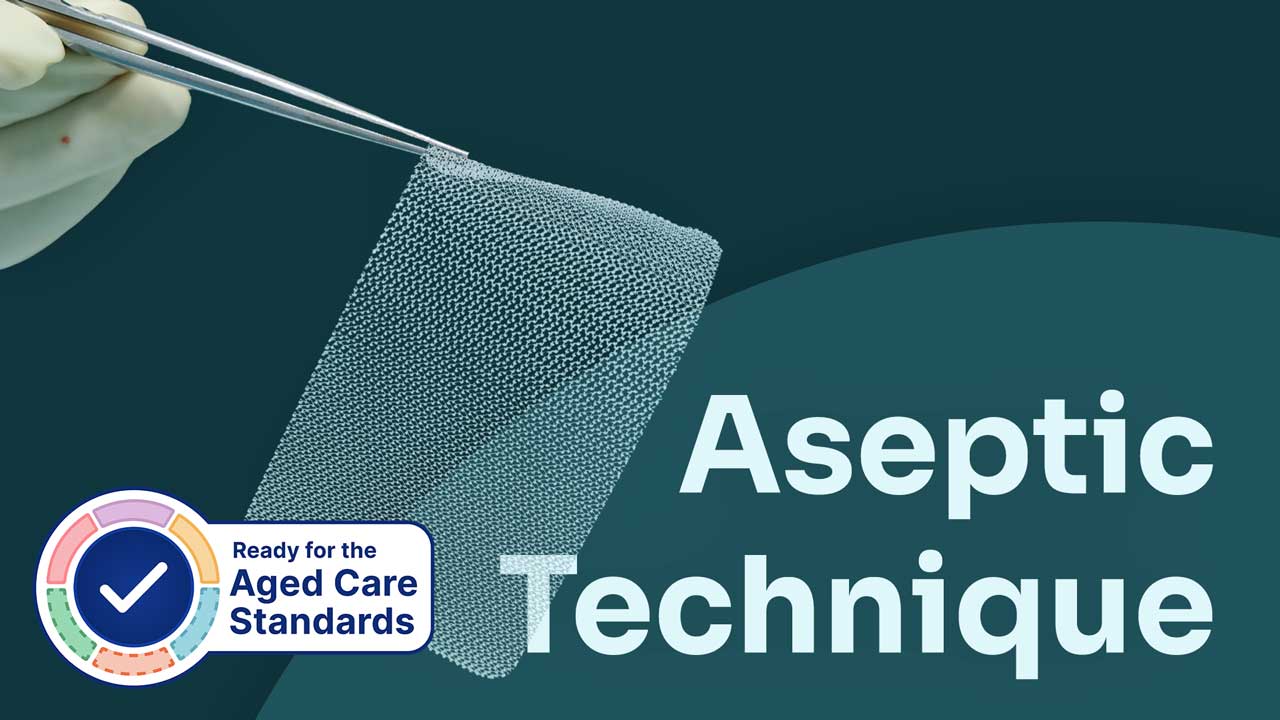There are approximately 165,000 incidences of healthcare-associated infection (HAI) every year in Australian acute care facilities alone, with over half of these being preventable (NHMRC 2023).
Aseptic technique is a fundamental component of infection control and prevention that helps to decrease the risk of HAIs.
What is Aseptic Technique?
Aseptic technique aims to achieve asepsis during invasive clinical procedures - that is, the absence of sufficient pathogens to cause an infection in the client (ACSQHC 2021).
It should be used when performing procedures that could potentially introduce pathogens to the client’s susceptible body sites to ensure that no contamination occurs via surfaces, equipment or the healthcare worker’s hands (SA Health 2022).
Poorly-performed aseptic technique has been identified as a significant contributor to preventable HAI (WACHS 2023).
It is important to note that achieving asepsis is not the same as being sterile, i.e. completely free from microorganisms. This is almost impossible to achieve unless the procedure is taking place in a specially equipped controlled environment (e.g. operating theatres) (ACSQHC 2021).
Aseptic Technique in the National Safety and Quality Health Service Standards
Aseptic technique is outlined in Action 3.11 of the National Safety and Quality Health Service Standards, under Standard 3: Preventing and Controlling Infections.
This action aims to minimise the risk of infection being transmitted during clinical procedures by ensuring health service organisations implement a risk-based aseptic technique process (ACSQHC 2023).
Health service organisations are required to:
- Identify procedures where aseptic technique should be used
- Assess the ability of staff to perform aseptic technique
- Address any competency gaps with training
- Ensure staff are complying with aseptic technique policies.
(ACSQHC 2023)
Aseptic Technique Under the Strengthened Aged Care Quality Standards
Standard 5: Clinical Care - Outcome 5.2: Preventing and controlling infections in clinical care under the strengthened Aged Care Quality Standards (Action 5.2.2) requires aged care providers to establish processes for reducing and managing infection when providing clinical care. These processes should include the use of aseptic technique (ACQSC 2024).
When is Aseptic Technique Used?
Activities that require aseptic technique include:
- Intravenous fluid or medicine preparation and administration
- Simple and complex wound dressing
- Urinary catheter insertion
- Intravenous cannula or central venous catheter insertion and maintenance
- Drainage bag emptying or changing
- Surgical procedures
- Venepuncture
- Collecting swabs and specimens.
(WACHS 2023)
Key Sites and Key Parts
The following two terms are integral to aseptic technique:
- Key sites include wounds, puncture sites and other breaches in skin integrity through which pathogens can enter the client’s body.
- Key parts are parts of equipment that make direct contact with the client or procedural equipment. Examples include wound dressings, catheter lubrication and needle tips. If key parts become contaminated, they may transmit pathogens to the client.
(NHMRC 2023)

Principles of Aseptic Technique
The primary goal of aseptic technique is to prevent key sites and key parts from coming into contact with pathogens. This is ensured through the following components of infection control:
Environmental Risks
Prior to commencing the procedure, staff must conduct a risk assessment. This should be the first step of the aseptic technique process. The aim is to determine whether there are any environmental risks present that could cause contamination through movement, touch or proximity (ACIPC 2015). Examples include:
- An excessive amount of people in close proximity
- A confined working area
- The privacy curtain moving or being in close proximity to the client
- Other clients in the same room using commodes
- Cleaning being performed in the same room
- Beds being made in the same room
- Bedside curtains
- Open windows
- Air conditioners or heaters in close proximity.
(ACIPC 2015; Kumar 2021)
Any environmental risks should be removed prior to performing the procedure (Kumar 2021).
Hand Hygiene
Hand hygiene is one of the most important measures for preventing infection transmission (Health.vic 2023). In aseptic procedures, hand hygiene is used to ensure that:
- Clients are not infected via the staff member’s hands or their own flora
- Staff do not spread or contract infections while performing the procedure.
(Health.vic 2023)
Staff must perform hand hygiene:
- Before touching the client
- Before performing the procedure
- After exposure to body fluids
- After touching the client, and
- After touching the client’s surroundings or equipment.
(Health.vic 2023)
Gloves
Gloves should be used to protect the client from contamination, as well as to protect the staff member from exposure to body fluids. They must be single use. If the staff member needs to touch a key site or key part, or if there is any risk of the staff member accidentally touching a key site or key part, sterile gloves must be worn. Non-sterile gloves are appropriate otherwise (Health.vic 2023; ACIPC 2015).
Non-Touch Technique
Staff should avoid touching key parts and key sites whenever possible, even if they are wearing sterile gloves. This is the safest way to avoid contamination of key sites and key parts (ACIPC 2015).
Protecting Key Sites and Key Parts
Once the key sites and key parts have been identified, they must be protected. Aseptic key parts must only make contact with key sites and other aseptic key parts (The Women’s 2020).
Aseptic Fields

The aseptic field is the working space wherein key parts are held and protected from contamination. The type of aseptic field that is required depends on the procedure, as well as the key sites and key parts involved (WACHS 2023).
There are three types of aseptic field:
- Micro critical aseptic fields are used to contain singular key parts. Examples include caps to protect syringes, sheaths to protect needles and covers or packaging.
- General aseptic fields are used to contain key parts that can be adequately protected by micro critical aseptic fields and non-touch technique. For example, a tray (the general aseptic field) containing capped syringes (the key parts). General aseptic fields must be used together with micro critical aseptic fields.
- Critical aseptic fields are used when key sites and key parts are more difficult to protect from contamination. In this case, the aseptic field itself is treated as a key part, meaning it must only make contact with other aseptic equipment. A critical aseptic field may be required if:
- The key sites or key parts are large
- There are several key sites or key parts
- The key parts cannot be protected with micro critical aseptic fields
- Non-touch technique is not feasible throughout the whole procedure.
(WACHS 2023; ACSQHC 2021; ACIPC 2015)
Decontamination
All key parts must be made aseptic before being re-used. For example, if a client has an IV cannula in-situ that has been disconnected from the intravenous fluid line 1, the intravenous line must be replaced with a new line and the IV cannula access site must be made aseptic before re-accessing it. Follow your organisation’s policies and procedures (Kumar 2021).
Equipment such as trolleys should also be decontaminated before use (Kumar 2021).
Types of Aseptic Technique
There are two types of aseptic technique: standard aseptic technique and surgical aseptic technique. The most appropriate type of aseptic technique should be chosen based on the procedure as well as the key sites and key parts involved.
Note that the terms ‘sterile technique’ and ‘clean technique’ are no longer used. They have been replaced by surgical aseptic technique and standard aseptic technique respectively.
| Standard aseptic technique | Surgical aseptic technique | |
|---|---|---|
| Number of key parts and key sites | Few | Many |
| Size of key parts and key sites | Small | Large |
| Complexity of procedure | Simple | Complex |
| Duration of procedure | Less than 20 minutes | More than 20 minutes |
| Aseptic field required | General aspect field and micro critical aseptic fields | Critical aseptic fields |
| Type of gloves required | Non-sterile (unless there is a risk of accidentally touching key sites or key parts) | Sterile gloves |
| Procedure examples |
|
|
(WACHS 2023; CHHS 2018)
Performing a Procedure Using Aseptic Technique
- Obtain consent from the client, check for allergies and ensure the client has been correctly identified.
- Perform risk assessment and control any environmental risks.
- Perform hand hygiene.
- Clean the work surface/tray/trolley.
- Determine whether a general or critical aseptic field is required. Prepare appropriately.
- Identify and gather the necessary equipment. Ensure there is no damage to the packaging and check expiry dates and sterility indicators. Ensure all other equipment is clean.
- Perform hand hygiene.
- Prepare the client. If there is a risk of exposure to body fluids, don gloves and remove them once you have finished preparing the client.
- Open equipment from the corners and drop it into the sterile field.
- Perform hand hygiene.
- Don gloves if required (either sterile or non-sterile, depending on whether you need to touch key sites or key parts or may accidentally do so).
- Perform the procedure, ensuring that:
- Sterile items are used once, then appropriately disposed of.
- Only sterile items make contact with the key site.
- Sterile items do not make contact with non-sterile items.
- Remove gloves and perform hand hygiene.
- Dispose of waste appropriately, then remove gloves.
- Clean equipment and perform hand hygiene.
- Document the procedure on the appropriate form, such as wound chart, etc.
(ACIPC 2015)
Always follow the World Health Organisation’s 5 Moments for Hand Hygiene while performing the procedure.
Aseptic Technique Risk Matrix
The Australian Commission on Safety and Quality in Health Care has developed a risk matrix to help organisations identify high-risk clinical areas or procedures, and determine whether staff competency needs to be reassessed. The matrix assesses:
- The clinical context wherein aseptic technique occurs and how often it occurs in that setting
- The type and frequency of the specific procedure
- How recently the specific staff member was assessed for competency in aseptic technique.
(ACSQHC 2018)
This tool uses a scoring system. Each component of the matrix should be added together to determine the risk score for a specific procedure.
| 1. The clinical context where aseptic technique occurs | |||
| Frequency (how often aseptic technique occurs in this setting) |
Controlled (e.g. theatres, interventional radiology, oncology units) |
Semi-controlled (e.g. medical wards) |
Uncontrolled (e.g. emergency department) |
| Infrequently | 1 = Low | 4 = Low | 6 = Medium |
| Occasionally | 4 = Low | 6 = Medium | 8 = High |
| Frequently | 6 = Medium | 8 = High | 10 = Very High |
| 2. Type of procedure | |||
| Frequency (how often the procedure is performed) |
Simple procedure (e.g. simple wound dressing) |
Complex procedure (e.g. wound debridement) |
Invasive procedure (e.g. insertion of a peripheral or central venous access device) |
| Infrequently | 1 = Low | 4 = Low | 6 = Medium |
| Occasionally | 4 = Low | 6 = Medium | 8 = High |
| Frequently | 6 = Medium | 8 = High | 10 = Very High |
| 3. How recently the specific staff member was last assessed for competency | ||||
| Recently (within the last 12 months) | Recently, but the staff member is working in a changed clinical context | 1-3 years ago | More than 3 years ago or unknown | |
| 1 = Low | 4 = Medium | 4 = Medium | 8 = High | |
Once the score for each of these three components has been determined, add them together to determine their total risk score. The organisation can then use this information to determine whether a reassessment of staff competency or other actions are required (ACSQHC 2018).
| Score | Risk |
|---|---|
| 3 - 9 | Low |
| 10 - 16 | Medium |
| 17 - 24 | High |
| 25 - 28 | Very high |
(All tables adapted from ACSQHC 2018)
Note: This article is intended as a refresher and should not replace best-practice care. Always refer to your organisation's policy on aseptic technique.
Test Your Knowledge
Question 1 of 3
True or false: A general aseptic field can be used on its own.
Topics
Further your knowledge
References
- Aged Care Quality and Safety Commission 2024, Standard 5: Clinical Care, Australian Government, viewed 14 May 2024, https://www.health.gov.au/resources/publications/strengthened-aged-care-quality-standards-august-2025?language=en
- Australasian College for Infection Prevention and Control 2015, Aseptic Technique - Technique During Invasive Clinical Procedures, ACIPC, viewed 2 October 2023, https://www.acipc.org.au/resources/aseptic-technique-resources/
- Australian Commission on Safety and Quality in Health Care 2023, Action 3.11 Aseptic Technique, Australian Government, viewed 2 October 2023, https://www.safetyandquality.gov.au/standards/nsqhs-standards/preventing-and-controlling-infections-standard/infection-prevention-and-control-systems/action-311
- Australian Commission on Safety and Quality in Health Care 2018, Aseptic Technique Risk Matrix, Australian Government, viewed 2 October 2023, https://www.safetyandquality.gov.au/sites/default/files/migrated/Aseptic-Technique-Risk-Matrix-Updated-November-2018.pdf
- Australian Commission on Safety and Quality in Health Care 2021, Principles for Aseptic Technique: Information for Healthcare Workers, Australian Government, viewed 27 September 2023, https://www.safetyandquality.gov.au/sites/default/files/2022-01/principles_for_aseptic_technique-_information_for_healthcare_workers_-_december_2021.pdf
- Canberra Hospital and Health Services 2018, Clinical Procedure: Aseptic Technique, Australian Capital Territory Government, viewed 2 October 2023, https://www.health.act.gov.au/sites/default/files/2020-02/Aseptic%20Technique.docx
- Health.vic 2023, Infection Control - Standard and Transmission-Based Precautions, Victoria State Government, viewed 2 October 2023, https://www.health.vic.gov.au/infectious-diseases/infection-control-standard-and-transmission-based-precautions
- Kumar, K 2021, What Are Examples of Aseptic Techniques?, MedicineNet, viewed 2 October 2023, https://www.medicinenet.com/infectious_germs_where_they_hide/article.htm
- National Health and Medical Research Council 2023, Australian Guidelines for the Prevention and Control of Infection in Healthcare, Australian Government, viewed 27 September 2023, https://www.safetyandquality.gov.au/publications-and-resources/resource-library/australian-guidelines-prevention-and-control-infection-healthcare
- SA Health 2022, Aseptic Technique, Government of South Australia, viewed 27 September 2023, https://www.sahealth.sa.gov.au/wps/wcm/connect/public+content/sa+health+internet/clinical+resources/clinical+programs+and+practice+guidelines/infection+and+injury+management/healthcare+associated+infections/prevention+and+management+of+infections+in+healthcare+settings/aseptic+technique
- WA Country Health Service 2023, Aseptic Technique Policy, Government of Western Australia, viewed 27 September 2023, https://www.wacountry.health.wa.gov.au/~/media/WACHS/Documents/About-us/Policies/Aseptic-Technique-Policy.pdf?thn=0
- The Women’s 2020, Procedure: Aseptic Technique, The Women’s, viewed 2 October 2023, https://thewomens.r.worldssl.net/images/uploads/downloadable-records/clinical-guidelines/aseptic-technique_280720.pdf
 New
New 

